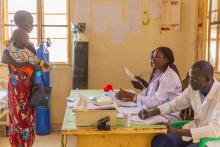Bridging the nutrition gap: WHO and partners strengthen care for malnourished children
Juba - South Sudan has one of the highest rates of malnutrition among children under five. About 2.1 million children under five are at risk of acute malnutrition. This includes 670 000 children who are severely wasted and 1.44 million who are moderately wasted.
To address severe acute malnutrition, the Ministry of Health, with support from the World Health Organization (WHO) and partners, has been implementing several initiatives to expand access to care for children in all the 10 States and three administrative Areas of the country.
Behind these efforts are teams of dedicated health workers and partners working tirelessly to strengthen systems and save lives. Their impact is being felt across stabilization centers and hospitals nationwide. “We appreciate WHO’s continued support in strengthening inpatient care for children with severe acute malnutrition and medical complications,” said Khamisa Ayoub, Director for Nutrition at the Ministry of Health. “This includes the development of guidelines and training packages, revision of job aids, provision of SAM kits, and capacity building for health workers at stabilization centers.”
WHO introduced the Quality-of-Care Improvement Tool for stabilization centres, a structured, step-by-step guide aligned with WHO standards. Forty-seven (47) health workers from fifteen (15) centres across the Central (Juba), Eastern (Torit), and Western (Yambio) Equatoria States have been trained to use the tool, supported by SAM kits, updated guidelines, and job aids. The Quality-of-Care Improvement Tool was piloted at Al Sabah Children’s Hospital this led to the identification of gaps and development of an action plan. These efforts are complemented by improved coordination, essential medicines, and monitoring systems to ensure consistent, high-quality care. “The training and supplies from WHO have transformed how we care for children with SAM,” says Dr. Gawar, a paediatrician at Al Sabah Children’s Hospital. “The tool is now adapted to our local context, helping health workers deliver consistent, high-quality services.”
These interventions are giving children a second chance at life across the country. In stabilization centers, mothers now arrive to find trained staff ready to respond, and care protocols that guide treatment. But while these gains are lifesaving, they also reveal how much more remains to be done. Persistent challenges and preventable deaths continue to underscore the urgent need for sustained investment in nutrition and child health services.
Based on the Al-Sabah Children’s hospital monthly paediatric death audits, over 50% of deaths are recorded at the stabilization centres. The main causes of these alarming rates are severe malaria, pneumonia, sepsis, and acute watery diarrhea (AWD) with dehydration or shock, which is particularly dangerous for children due to their smaller and developing bodies, making them more susceptible to infections. These stark figures highlight that malnutrition is more than a medical issue. It is a crisis with far-reaching consequences for children and their communities. The human toll of malnutrition is compounded by the country’s overall high childhood mortality, underscoring the urgent need for strengthened health and nutrition services across South Sudan. The country has one of the highest childhood mortality rates in the world, with an Infant Mortality Rate (IMR) of 63.3 per 1 000 and children under 5 years mortality rates of 97.9 deaths per 1 000 live births, respectively.
“Malnutrition among children under five, is not just a health concern but is a crisis that touches every aspect of life. It affects more than just physical health, delays development, and limits a child’s ability to learn and thrive” says Dr Humphrey Karamagi, WHO Representative to South Sudan. “Seeing children dying is unacceptable and that is why WHO is supporting the Ministry of Health and partners to scale up services at all the nutritional sites, strengthening the health system and ensuring that no one including children is left behind.” The new tool is designed to support clinicians, paediatricians, nutritionists, and nurses in enhancing the quality of care provided to children in stabilization centres.
Technical Contacts:
Dr Lucy Meseka Aggrey, Email: mesekal [at] who.int (mesekal[at]who[dot]int)
Dr Kuol Alier, Email: alierk [at] who.int (alierk[at]who[dot]int)
Communication Officer
Mobile: +211 921736375
Email: atema [at] who.int (atema[at]who[dot]int)
Communications officer
Emaill: rutaremaraa [at] who.int (rutaremaraa[at]who[dot]int)
